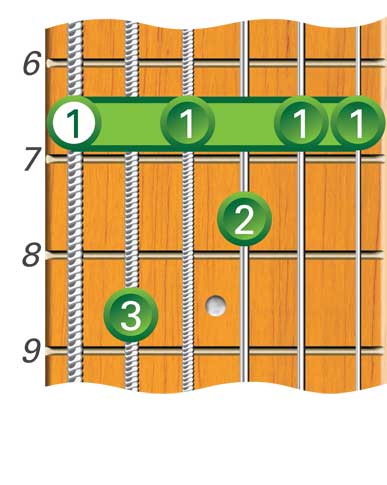
Seventh Bar Chords
The next type of bar chord you will learn is the seventh bar chord in both the root 6 and root 5 positions.
Seventh Bar Chord - Root Six

E7


F7

The seventh bar chord in the root 6 position is derived from the basic E seventh chord and as with other root 6 bar chords the root note is found on the 6th string. Therefore, positioning this bar chord on the first fret will produce an F seventh.
Study the following chord diagrams which are all the seventh bar chords used in the following example.
G7

B7

C7

A7

D7

A basic syncopated rhythm counted as "1 and 2 and miss and 4 and", is used for example 9.
Rhythm Pattern



The Seventh Bar Chord - Root Five

A7


A#7 or Bb7

The seventh bar chord in the root 5 position is derived from the basic A seventh chord, and as with other root 5 bar chords the root of the chord is found on the 5th string. Therefore, positioning this bar chord on the first fret will produce an A# or Bb seventh.
All bar chords used in example 10, including the root 5 seventh bar chord, are summarized in the following chord diagrams.
C

C7

F

F7

G7

A triplet rhythm counted as "1 and ah, 2 and ah, 3 and ah, 4", is used in example 10..
Rhythm Pattern



Alternative Fingerings
There is a popular alternative fingering for the seventh bar chord in both the root 6 and the root 5 position. These fingerings have a much stronger seventh sound that the standard seventh bar chord fingerings and although more difficult to play are frequently used.

Seventh Bar Chord Root Six

Seventh Bar chord Root Five
Examples 11 - 13 use all the types of chords discussed so far. Study the following diagrams which summarize all the chords used in the following examples.
A

C

D7

F7

E7

C#m

F#m

G7

A7

B7

Rhythm Pattern


Rhythm Pattern


Rhythm Pattern



The following Country progressions use all the bar chord types discussed so far. Try to use the most practical root bar chord to change to with each change. The same rhythm pattern is used for all three examples.
Rhythm Pattern










